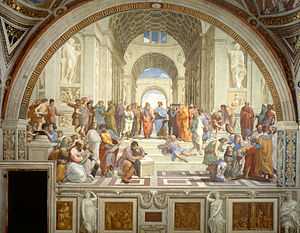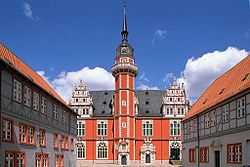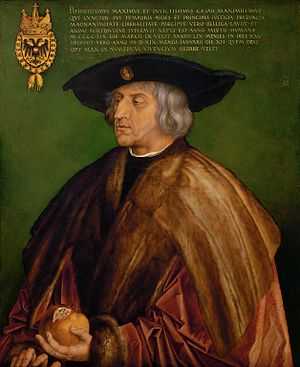German Renaissance
| The Renaissance |
|---|
 |
| Topics |
| Regions |
The German Renaissance, part of the Northern Renaissance, was a cultural and artistic movement that spread among German thinkers in the 15th and 16th centuries, which originated from the Italian Renaissance in Italy. This was a result of German artists who had traveled to Italy to learn more and become inspired by the Renaissance movement. The German Renaissance pushed classical thinking, arts, and the natural sciences to the forefront during this period of thinking within Germany.
Background
The greatest mark of the Renaissance was the renewed interest in classical learning. Documents, papal or not, were being brought to the surface for examination and study. Classical learning and study was a must for any person living in the renaissance and was considered a great part of one's education. The basis of literature and art in this time were references back to times with Ancient Greek and Roman societies and mythology. The basis of natural science developed from that same look back into Greek and Roman philosophies and teaching, however they were more developed.
One thing to remember is this transition back to classical learning did not happen in a few years, the transition itself took over a century to occur within Germany. During this period many artists, scientists, and men of the church traveled to Italy. They brought back these ideals, and help thrust Germany into renaissance. The greatest influences of the German renaissance are marked for having brought the basis of Italian renaissance thinking, while still retaining their German culture. The Renaissance was also the result of economic development. At the beginning of the 16th century, Germany was one of the most prosperous countries in Europe in spite of a relatively low level of urbanization when compared to Italy or the Netherlands.[1] It benefited from the wealth of certain sectors such as metallurgy, mining, banking and textile. More importantly, book-printing was more developed than in most other countries, something which facilitated the spread of knowledge.
Architecture

The Renaissance Architecture in Germany was inspired first by German philosophers and artists such as Albrecht Dürer and Johannes Reuchlin who visited Italy. Important early examples of this period are especially the Landshut Residence, the Castle in Heidelberg, Johannisburg Palace in Aschaffenburg, the City Hall and Fugger Houses in Augsburg and St. Michael in Munich. A particular form of Renaissance architecture in Germany is the Weser Renaissance, with prominent examples such as the City Hall of Bremen and the Juleum in Helmstedt.
In July 1567 the city council of Cologne approved a design in the Renaissance style by Wilhelm Vernukken for a two storied loggia for Cologne City Hall. St Michael in Munich is the largest Renaissance church north of the Alps. It was built by Duke William V of Bavaria between 1583 and 1597 as a spiritual center for the Counter Reformation and was inspired by the Church of il Gesù in Rome. The architect is unknown. Many examples of Brick Renaissance buildings can be found in Hanseatic old towns, such as Stralsund, Wismar, Lübeck, Lüneburg, Friedrichstadt and Stade. Notable German Renaissance architects include Friedrich Sustris, Benedikt Rejt, Abraham van den Blocke, Elias Holl and Hans Krumpper.
Influential people
Johannes Gutenberg (c. 1398–1468)

Born Johannes Gensfleisch zur Laden,[2] Johannes Gutenberg is widely considered the most influential person within the German Renaissance. As a free thinker, humanist, and inventor, Gutenberg also grew up within the Renaissance, but influenced it greatly as well. His best-known invention is the printing press in 1440. Johannes Gutenberg's press allowed the humanists, reformists, and others to circulate their ideas. Essentially this is the basis of the Renaissance, the change and exchange of ideas. He is also known as the creator of the Gutenberg Bible, a crucial work that marked the start of the "Gutenberg Revolution" and the age of the printed book in the West.
Johann Reuchlin (1455–1522)
Johann Reuchlin was the most important aspect of world culture teaching within Germany at this time. He was a scholar of both Greek and Hebrew. Graduating, then going on to teach at Basel, he was considered extremely intelligent. Yet after leaving Basel, he had to start copying manuscripts and apprenticing within areas of law. However, he is most known for his work within Hebrew studies. Unlike some other "thinkers" of this time, Reuchlin submerged himself into this, even creating a guide to preaching within the Hebrew faith. The book, titled De Arte Predicandi (1503), is possibly one of his best-known works from this period.
Albrecht Dürer (1471–1528)
Albrecht Dürer was at the time, and remains, the most famous artist of the German Renaissance. He was famous across Europe, and greatly admired in Italy, where his work was mainly known through his prints. He successfully integrated an elaborate Northern style with Renaissance harmony and monumentality. Among his best known works are Melencolia I, the Four Horsemen from his woodcut Apocalypse series,[3] and Death, the Knight, and the Devil.[4] Other significant artists were Lucas Cranach the Elder, the Danube School and the Little Masters.
Martin Luther (1483–1546)
Martin Luther initiated the Protestant Reformation through the criticisms of church practices such as selling indulgences, which he published in his Ninety-Five Theses of 1517. Luther also translated the Bible into German, making the Christian scriptures more accessible to the general population and inspiring the standardization of the German language.
See also
References
- ↑ German economic growth, 1500–1850, Ulrich Pfister
- ↑ Johann Gutenberg at the New Catholic Encyclopedia
- ↑ Four Horsemen
- ↑ Knight, Death, and Devil